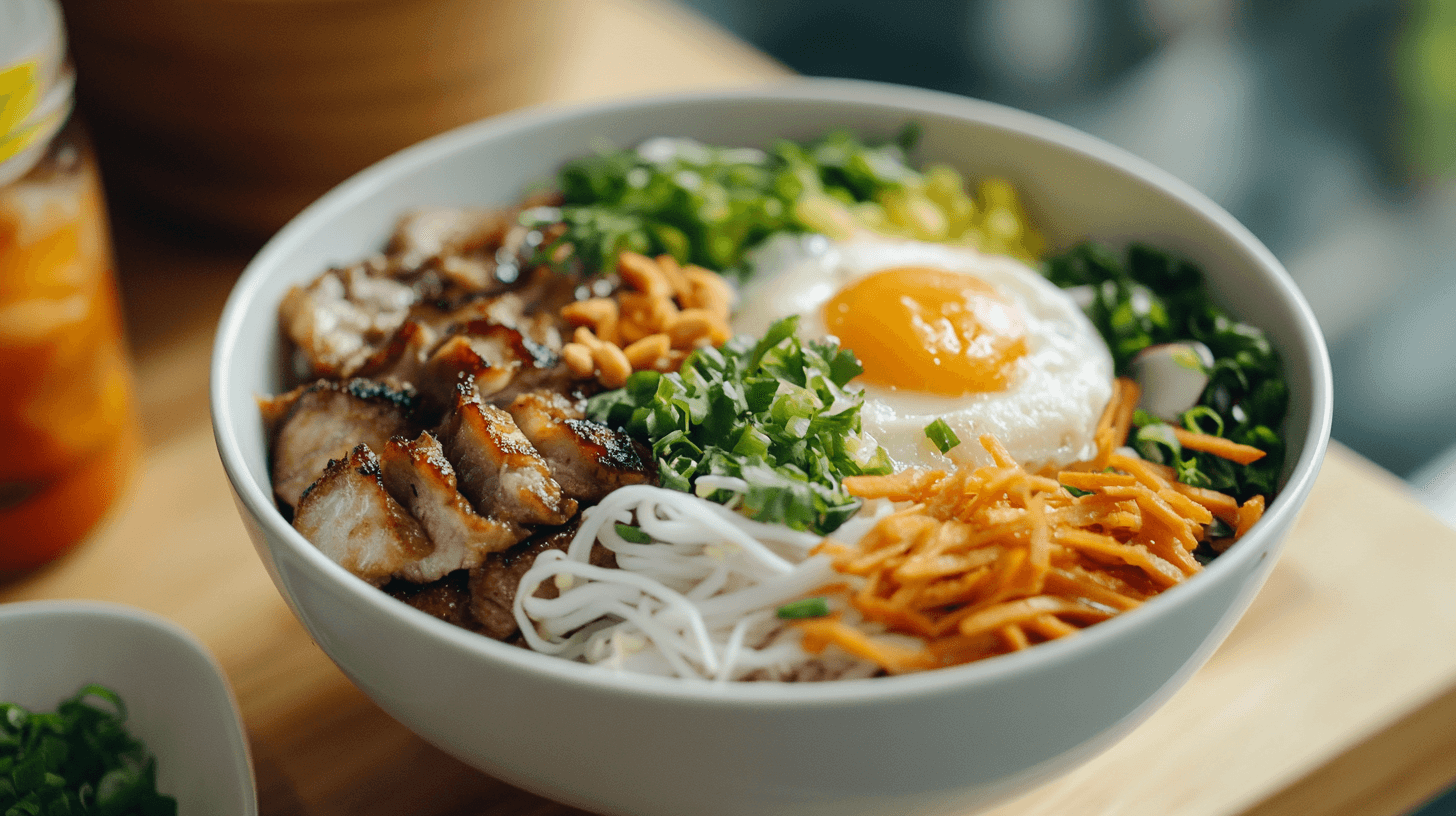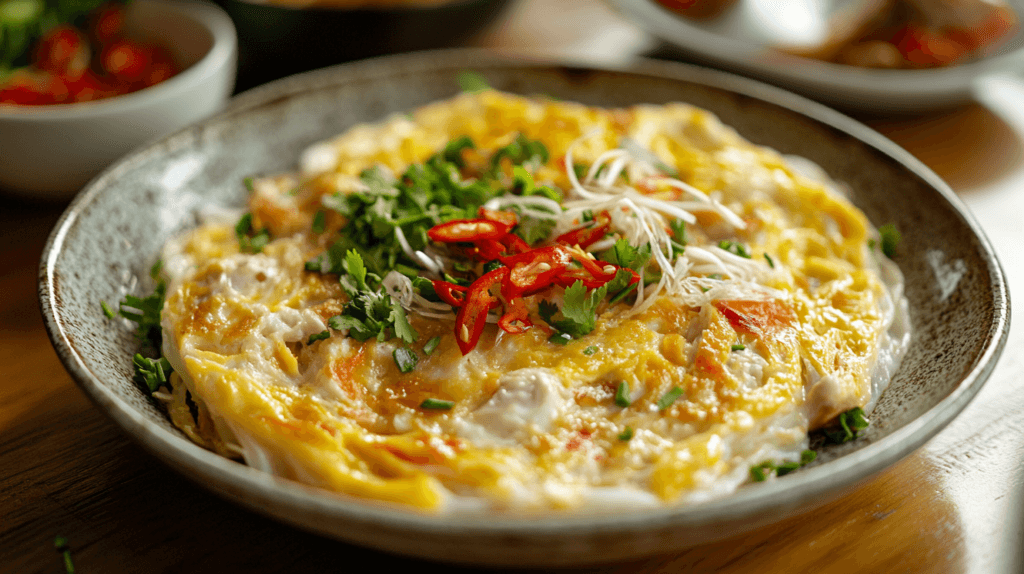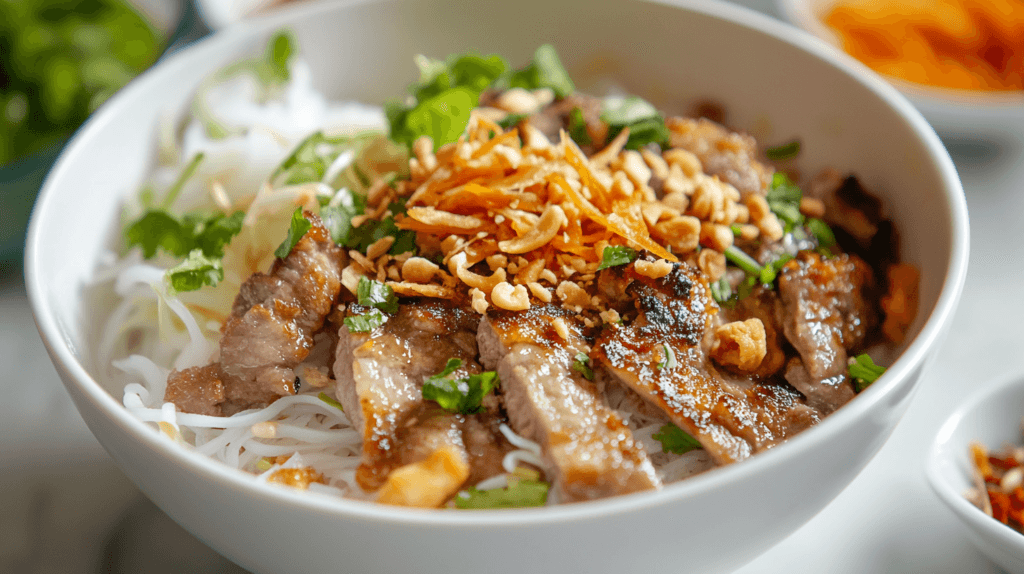Experience the vibrant flavors of Vietnam with these Vietnamese Breakfast Ideas. Rooted in tradition and known for their balance of textures and tastes, Vietnamese breakfasts are a unique way to start the day. From hearty soups to light baguettes and refreshing drinks, these recipes showcase the diversity and deliciousness of Vietnamese cuisine.
Why Vietnamese Breakfasts Are a Must-Try
Vietnamese breakfasts are the perfect balance of nourishment and flavor, offering options that range from light and refreshing to filling and comforting. Incorporating fresh herbs, bold seasonings, and a mix of textures, these breakfasts are not just meals but experiences. Whether you want a quick bite or a leisurely feast, these recipes bring the authenticity and vibrancy of Vietnam to your table.
For more breakfast inspiration, explore our Breakfast Category. Pair these dishes with our Avocado Breakfast Sandwich for a fusion-inspired morning.
Traditional Vietnamese Breakfast Ideas
1. Phở (Vietnamese Beef Noodle Soup)
A hearty bowl of rice noodles, beef, and aromatic broth.
- Ingredients: Beef bones, rice noodles, thinly sliced beef, star anise, cinnamon, ginger, and fresh herbs (cilantro, Thai basil).
- Method: Simmer beef bones with spices to create a flavorful broth. Serve over rice noodles with fresh herbs and lime wedges.
2. Bánh Mì (Vietnamese Baguette Sandwich)
A crusty baguette filled with savory and fresh ingredients.
- Ingredients: Baguette, pâté, sliced pork or chicken, pickled carrots and daikon, cucumber slices, and fresh cilantro.
- Method: Assemble the fillings in the baguette, spread with pâté, and enjoy.
3. Xôi Mặn (Savory Sticky Rice)
A hearty and savory breakfast made with sticky rice and toppings.
- Ingredients: Sticky rice, Chinese sausage, shredded pork, fried shallots, and soy sauce.
- Method: Steam sticky rice, top with sausage, pork, and shallots, and drizzle with soy sauce.
4. Bánh Cuốn (Steamed Rice Rolls)
Delicate rice rolls filled with savory ground pork and mushrooms.
- Ingredients: Rice flour batter, ground pork, wood ear mushrooms, and fried shallots.
- Method: Steam the batter into thin sheets, fill with pork and mushrooms, and serve with fish sauce dipping sauce.
5. Cháo (Rice Porridge)
A comforting dish similar to congee, perfect for mornings.
- Ingredients: Rice, chicken or pork, ginger, scallions, and fish sauce.
- Method: Simmer rice with broth until creamy, top with shredded meat, scallions, and a dash of fish sauce.
6. Cà Phê Sữa Đá (Vietnamese Iced Coffee)
A strong, sweet coffee drink made with condensed milk.
- Ingredients: Dark roast Vietnamese coffee, condensed milk, and ice.
- Method: Brew the coffee, mix with condensed milk, and pour over ice for a refreshing drink.
7. Trứng Ốp La (Sunny-Side-Up Eggs with Baguette)
A simple yet flavorful breakfast dish.
- Ingredients: Eggs, baguette slices, soy sauce, and fresh herbs.
- Method: Fry eggs sunny-side-up and serve with soy sauce and toasted baguette slices.
For a similar dish, try our French Toast Recipe for a sweet take on bread-based breakfasts.
Customizing Vietnamese Breakfast Ideas
- Vegetarian Variations: Replace meat with tofu or mushrooms in phở, xôi mặn, or bánh mì.
- Add Spice: Include chili paste or fresh chili slices for an extra kick.
- Sweet Options: Opt for xôi ngọt (sweet sticky rice) with coconut and mung bean for a dessert-like breakfast.
- Experiment with Fillings: Try different proteins and fresh vegetables in bánh mì or bánh cuốn.
For more creative options, visit our Snacks Category.
Tips for Vietnamese Breakfasts
- Use Fresh Herbs: Cilantro, Thai basil, and mint are essential for authentic flavors.
- Prepare Ahead: Make broths, pickled vegetables, or sticky rice the night before for quick assembly in the morning.
- Balance Flavors: Aim for a mix of savory, sweet, sour, and spicy elements in each dish.
- Pair with Coffee: Vietnamese iced coffee or tea is the perfect companion to these breakfasts.
Pair these dishes with our Chia Seed Pudding Recipe for a modern and healthy side.
Serving Suggestions for Vietnamese Breakfasts
- As a Brunch Spread: Serve multiple dishes, like phở, bánh mì, and xôi mặn, for a Vietnamese-inspired brunch.
- On the Go: Wrap bánh mì or bánh cuốn for portable breakfast options.
- With Dipping Sauces: Serve fish sauce, hoisin sauce, or soy sauce on the side for added flavor.
Nutrition Facts for Vietnamese Breakfast
Average per serving (based on a traditional Vietnamese breakfast, approximately 2 servings):
- Calories: 300–500
- Protein: 10–20g
- Carbohydrates: 35–60g
- Sugars: 5–10g
- Dietary Fiber: 3–6g
- Total Fat: 10–20g
- Saturated Fat: 3–7g
- Sodium: 400–600mg
A Vietnamese breakfast is known for its balance of flavors, textures, and aromas. Whether it’s a steamy bowl of pho, a crispy bánh mì, or a light bánh cuốn, the cuisine offers a nourishing and flavorful way to start your day.
Regional Variations of Vietnamese Breakfast
Breakfast in Vietnam varies by region, offering a glimpse into the country’s diverse culinary traditions:
Northern Vietnamese Pho
- Key Ingredients: Rice noodles, beef or chicken, herbs, and aromatic broth.
- Flavor Profile: Warm, savory, and herbal.
- Pairing: Enjoy with a squeeze of lime and a side of bean sprouts.
Central Vietnamese Bánh Bèo
- Key Ingredients: Steamed rice cakes topped with shrimp, scallions, and crispy pork.
- Flavor Profile: Light, savory, and slightly sweet.
- Pairing: Best with fish sauce for dipping.
Southern Vietnamese Bánh Mì
- Key Ingredients: Crispy baguette, pâté, pickled vegetables, and meats.
- Flavor Profile: Crunchy, tangy, and flavorful.
- Pairing: Complement with Vietnamese iced coffee (cà phê sữa đá).
Hue-Style Bún Bò Huế
- Key Ingredients: Spicy beef noodle soup with lemongrass.
- Flavor Profile: Bold, spicy, and aromatic.
- Pairing: Serve with fresh herbs and lime.
Countryside Cháo (Rice Porridge)
- Key Ingredients: Cooked rice, pork or chicken, and scallions.
- Flavor Profile: Mild, soothing, and hearty.
- Pairing: Enjoy with fried dough sticks (quẩy) on the side.
Fun Cooking Techniques for Kids
Get kids involved in preparing Vietnamese breakfast dishes with these fun activities:
Rolling Fresh Spring Rolls
- Activity: Help kids wrap rice paper around fresh vegetables and shrimp.
- Learning Outcome: Teaches fine motor skills and introduces them to traditional preparation methods.
Topping Pho Bowls
- Activity: Let kids add bean sprouts, herbs, and lime wedges to their pho.
- Learning Outcome: Encourages creativity and an appreciation for presentation.
Assembling Bánh Mì Sandwiches
- Activity: Allow kids to spread pâté and layer meats and vegetables inside baguettes.
- Learning Outcome: Introduces them to balance and layering flavors.
Decorating Rice Cakes
- Activity: Show kids how to garnish bánh bèo with shrimp, crispy pork, and scallions.
- Learning Outcome: Inspires attention to detail and culinary artistry.
Kitchen Tools to Elevate Vietnamese Breakfast
- Pho Pot or Stockpot
- Essential for simmering rich, aromatic broths.
- Rice Paper Rolling Mat
- Handy for making fresh spring rolls.
- Steam Tray or Bamboo Steamer
- Perfect for preparing bánh bèo or bánh cuốn.
- Sharp Knife
- Ideal for slicing meats and vegetables for bánh mì or spring rolls.
- Mortar and Pestle
- Useful for crushing garlic, chilies, or spices for dipping sauces.
- Wok or Skillet
- Great for stir-frying fillings or frying rice.
- Fine Mesh Strainer
- Helps clarify broths for pho or cháo.
Common Mistakes to Avoid
- Overloading Pho with Toppings
- Keep it balanced to let the broth’s delicate flavors shine.
- Using Stale Baguettes for Bánh Mì
- Always use freshly baked baguettes for the best texture.
- Oversteaming Rice Cakes
- Steam bánh bèo just until set to prevent a gummy texture.
- Skipping Fresh Herbs
- Herbs like cilantro, basil, and mint are essential to Vietnamese breakfasts.
- Undercooking Broth
- Take the time to simmer pho or bún bò huế broth for maximum flavor.
Creative Add-Ins
- Herbs and Greens
- Include mint, cilantro, or Thai basil for freshness.
- Pickled Vegetables
- Add pickled carrots or daikon for tangy crunch in bánh mì or rice bowls.
- Nuts and Seeds
- Sprinkle roasted peanuts or sesame seeds over rice dishes.
- Eggs
- Top cháo or bánh mì with a poached or fried egg for added richness.
- Chilies
- Incorporate fresh or dried chilies for heat and depth of flavor.
How to Double or Scale Vietnamese Breakfast
- Batch Cook Broth
- Prepare large quantities of pho or cháo broth and freeze for later use.
- Make Extra Bánh Mì Fillings
- Pre-cook meats and prepare vegetables for quick assembly during busy mornings.
- Freeze Spring Roll Components
- Prep and freeze fillings to simplify rolling fresh batches later.
- Steam in Bulk
- Steam larger quantities of bánh bèo or bánh cuốn for a group breakfast.
How to Store Vietnamese Breakfast Dishes
- Refrigeration
- Store cooked broths, rice cakes, or fillings in airtight containers for up to 3 days.
- Freezing
- Freeze pho broth or cooked dumplings for up to 3 months.
- Reheating
- Warm dishes gently on the stovetop to retain flavors and textures.
- Separating Components
- Store broth, noodles, and toppings separately for easier reheating.
Vietnamese Breakfast in Culture
Breakfast in Vietnam is more than just a meal; it’s a cultural experience that reflects the country’s rich culinary heritage. From bustling street-side pho vendors to homemade cháo, these dishes bring together family, tradition, and a love for fresh ingredients.
Whether you’re enjoying a casual breakfast on the go or indulging in a leisurely meal at home, Vietnamese breakfast offers a harmonious blend of flavors, textures, and aromas.
How to Adapt Vietnamese Breakfast for Special Diets
- Gluten-Free Option
- Use rice noodles and tamari instead of soy sauce.
- Low-Sodium
- Opt for homemade broths and use less fish sauce.
- Dairy-Free
- Most traditional Vietnamese breakfasts are naturally dairy-free.
- Vegan-Friendly
- Replace meats with tofu or mushrooms in pho, bún bò huế, or bánh mì.
- Low-Carb
- Substitute rice noodles with zucchini noodles or shirataki noodles.
How to Adapt Vietnamese Breakfast for Special Occasions
- Festive Gatherings
- Add colorful garnishes like edible flowers to bánh bèo or spring rolls.
- Team Breakfasts
- Set up a pho or bánh mì bar with customizable toppings.
- Family Brunches
- Serve a variety of dishes, including cháo, bánh cuốn, and iced coffee.
- Casual Weekends
- Prepare simple, comforting dishes like cháo or fried rice with eggs.
- Cultural Celebrations
- Incorporate traditional desserts like chè (sweet soup) alongside breakfast dishes.
FAQs About Vietnamese Breakfast
Can I make these dishes vegetarian?
Yes! Use vegetable broth for phở and cháo, and substitute tofu for meat in bánh cuốn and bánh mì.
How do I store leftovers?
Refrigerate components like broths, rice, or fillings separately in airtight containers and reheat as needed.
Are these breakfasts gluten-free?
Many dishes, like phở, xôi mặn, and cháo, are naturally gluten-free. For bánh mì, use gluten-free baguettes.
What’s the best way to enjoy Vietnamese iced coffee at home?
Invest in a Vietnamese coffee filter (phin) for authentic brewing.
Explore More Recipes Like These
If you enjoyed these ideas, try:
- Spring Rolls Recipe for another Vietnamese-inspired dish.
- Avocado Breakfast Sandwich for a fusion breakfast option.
These Vietnamese Breakfast Ideas offer a delightful mix of traditional and modern flavors, perfect for any morning. Whether you’re savoring a hot bowl of phở or enjoying a quick bánh mì, these recipes bring the rich culinary heritage of Vietnam to your table. Start your day with these vibrant and nourishing meals today!



